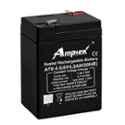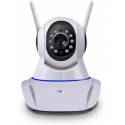Translate:
Know More about Batteries and their Uses
Batteries are nothing but the collection of cells (one or more). These cells create a flow of electrons within the circuit when they chemically react with each other. Batteries are mainly used as a primary source of power supply for any wireless electronic gadgets such as laptops, smartphones, remote controllers, watches, etc. apart from these more powerful batteries are used as a power source mainly for electric vehicles and in space vehicles.
Presently in the market you will find different types of batteries which can be used for particular purposes which is pretty much confusing. To clear this confusion, we have brought this ultimate guide which is based on batteries.
In this article we will be briefly discussing some few major types of batteries along with their uses, advantages and disadvantages. So, let's get started
Types of batteries:
-
Rechargeable batteries:
Rechargeable batteries, also known as the secondary batteries are those batteries which can be again charged when they are completely drained out. The batteries can be charged using the DC current which is applied to their terminals. They can also be charged using battery chargers.
Rechargeable batteries are mostly used in devices in which the batteries drain too fast or if it is impossible to use a single battery and when it is too expensive for replacing the batteries.
Secondary batteries with small capacity are used in electronic devices such as smartphones, smart watches, power banks, etc. While, secondary batteries with high capacity are used in electrical vehicles and in high-drain applications such as in electricity generation plants for load levelling.
Advantages:
- Can be recharged when they are drained out
- High output power
- Low battery price
- Can be used for a long period of time
Disadvantages:
- Heavy
- Occupies more space
- Low power density
Uses:
- Portable electronic gadgets
- Light power consuming vehicles such as golf-carts, electric scooters and bicycles, etc
- For uninterrupted power supply
- Battery storage power stations
-
Non rechargeable batteries:
Non rechargeable batteries also known as Primary Batteries. Unlike rechargeable batteries, non rechargeable batteries cannot be recharged once they are drained out completely.
Non rechargeable batteries are available in various forms which range from AA batteries to coin cells. Such batteries are mainly used where the recharging of the battery is practically impossible. The best example where these batteries are used can be the military equipment which are battery powered and military grade devices.
These batteries are most of the time used in those devices which require low power for operating purposes. They are used in TV remote controllers, wrist watches, wall clocks, etc.
Advantages:
- Life cycle is more
- High efficient and is more compatible for powering most of the portable devices
- Longer shelf life
- Low leakage
- Low internal resistance so that even in idle state discharge is less
Disadvantages:
- High battery price
Uses:
- In remote controllers
- Kids toys
- Laptop mouse
- Electronic keys of vehicles
Top Sellers

Amptek 6V 4.5Ah Black Sealed Rechargeable SLA Industrial Battery
₹99936% OFF₹499

IBS 720p Digital Security Double Antenna Wireless CCTV IP Camera
₹599979% OFF₹1058
-
Dry Cell:
Dry cell is nothing but an electric battery cell which is most of the time used in home electronic devices which are portable. The dry cell can be classified as both a primary cell and a secondary cell. A primary battery cell is such that it cannot be recharged nor reused when it completely drains out. Whereas a secondary battery cell can be recharged using the battery charger. Battery chargers are connected to the secondary battery cell which generates the chemical reactions in the cell and recharges it.
Dry cells are to be stored in cool places as these batteries tend to accelerate their self-discharge process at high temperatures. Also, these cells tend to expand and even rupture when they are exposed to high temperature.
Advantages:
- Easy to use in portable home electronic device
- Dry battery cells are safe while transportation
- These cells are lightweight and small
- If the dry cell is secondary type, then it can be recharged using battery charger
Disadvantages:
- If stored in high temperature, these battery cells self discharge
- Chemicals used in these cells are too acidic for the skin
Uses:
- Flashlights
- Old radios
- Old cameras
-
Inverter and Battery:
An inverter is a simple device which converts the direct current voltage to an alternate current voltage. Most of the time, the inverters are used as standalone devices for equipment such as the solar power supply. Apart from this, both the inverter and battery are used as a combination for having backup power supply.
The inverter and battery combination comes to use when there are sudden power cuts during night. The DC current is taken from the batteries which are charged separately and is converted into AC by the inverter. Then, this same AC current is used for the working of appliances which are connected to the inverter.
Other than this, the other configuration where an inverter can be used is in the main power supply unit or an UPS. Even in this, the inverter and battery combination is used. In the main power supply unit, the input DC for the inverter is taken from rectified mains AC supply in PSU or from the rectified AC from the UPS only when there is power. But, when there is no power, the batteries act as the input DC source for these inverters.
Advantages:
- Can step up or step down the voltage
- Gives an electrical isolation in between the input and output
- Supplies AC voltage using DC source
- Energy efficient method of changing the voltage
Disadvantages:
- Initial cost is high
- If the inverter is continuously overcharged, the water cannot be replaced
- Only the chargers which can be voltage regulated are to be used
- For extended life the charge voltage must be limited
Uses:
- In homes as power backups
- Standalone device for home appliance devices
Bonus Tip:
Though there are still many brands of batteries available in the market, Power zone batteries are considered as one of the best available in the market. Power zone batteries use the best technology for making their batteries. Power zone battery are factory charged, wet shipped, ready to fit batteries and also provide power at all room temperatures.
Further, to get the best inverter for home, log in to the moglix.com. Here you can find a number of varieties of inverters from which you can select the best inverter for your home.
Well, this was some brief discussion regarding the batteries and their major types. Make sure to make the best use of this article and for any information, log in to the moglix.
Battery: FAQs
Q. What does a battery mean?
A. A battery is nothing but a collection of cells (one or more). These cells produce the flow of electrons within a circuit when they chemically react with each other. Batteries are used as a power source for electrical devices such as smartphones, flashlights, etc.
Q. How much does a battery cost?
A. The cost of the battery varies depending on the companies producing it. Apart from this, factors such as the type of battery, the battery's output and several other factors affect the cost.
Q. What is battery and its types?
A. A battery is a collection of cells which is used as a source of power supply for electrical devices. Though there are many types of batteries available in the market, there are 2 major types. They are Primary Battery (Non-rechargeable) and Secondary Battery (Rechargable).
Q. What are the 3 types of batteries?
A. The 3 types of batteries are:
- Primary batteries also known as non-rechargeable batteries.
- Secondary batteries, also known as rechargeable batteries.
- Dry cell batteries that store chemical energy which can be converted into electrical energy.
Q. What are the signs of bad battery?
A. The signs of a bad battery are:
- Low storage capacity
- Does not get charged properly
- Fast discharging even when it is idle or not being used
- Low power output




